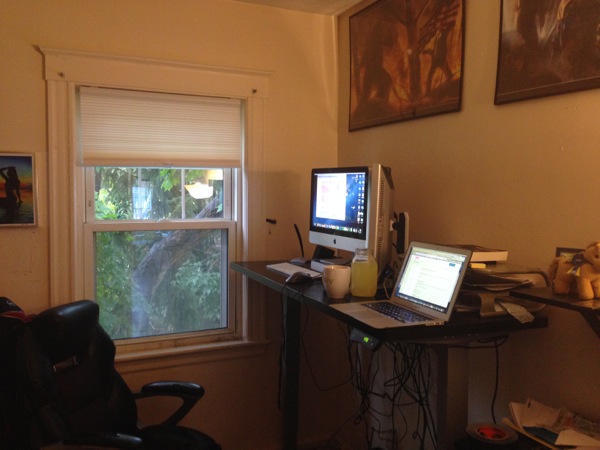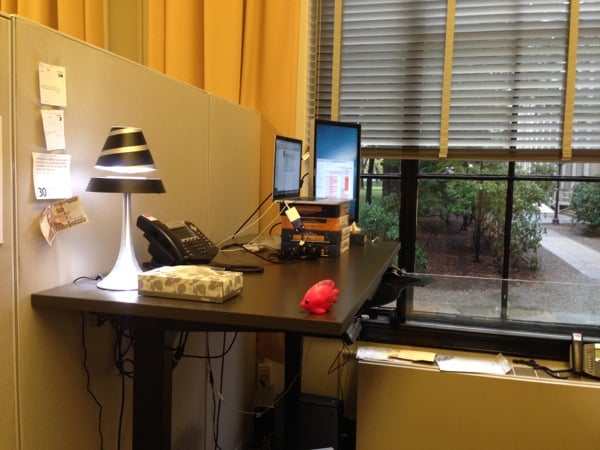
This Is How I Read by Chris Peterson SM '13
productivity hacks, but for reading applications
I really love the “day in the life” posts that have gone up recently (see, e.g., Krystal, Rachel, Ceri, Ana). I’ve been thinking about doing one, but it’s a bit different for me right now, because we’ve started to meet in Early Action committee and I don’t think:
9:00AM: arrive at work
9:30AM-5:30PM: [redacted]
5:30PM: walk home in a daze of decisions
would make for a particularly interesting blog. So instead, I figured I’d give you a window into a day in the life of reading applications.
We’ve written countless posts on reading in the abstract: what we look for in your applications, how bleary-eyed we get from reading them, and so on. But the specific technical configuration (the way an abstract process is practiced, embodied, manifest in some material form) I think is just as interesting, at least if, like me, you’re a fan of both productivity hacks and science-technology studies.
As most of you know, our Early Action deadline is November 1, and our Regular Action deadline is January 1. But “reading season” begins in late October, when QuestBridge applications become available, and extends well through February, as we consider regular applicants. During this time, we read applications as they become complete, and we don’t stop reading until we have read all the applications, period. We read at night, we read on weekends, we read during holiday breaks; when you are hired as an admissions officer at MIT, it is made clear in your contract that night/weekend work is expected from October to April. In return, your job is more than a job. That’s the tradeoff every admissions professional makes.
Unlike some parts of the country and the world, here in New England we have seasons: climate cycles characterized both by familiar trends and unexpected exceptions to those trends. Reading season (and we call it that) works the same way. I begin each academic year anticipating reading applications as surely as I would anticipate needing a coat and boots. Where the wind blows and the snowflakes start to fall is only somewhat predictable and depends on a complex set of factors mostly beyond my understanding or control.
Generally speaking, during reading season I wake up at 6 AM. I’ve come to rely on a natural light alarm clock to help me get started during the admittedly long and dark Boston winter, when I often begin and end the workday without much natural light. I take comfort from the fact that the beaver was chosen as MIT’s mascot in part because “his habits are nocturnal, he does his best work in the dark.”
By 7 AM, I am usually either running around the Charles, on my way to the MIT gym, or running around the Charles on my way to the gym. Ethan Zuckerman, who was my PI during graduate school, has blogged about how “walking is critical to my psychological health”; in fact, he just had two treadmill desks installed over in Civic so that he and others can have walking meetings during the day. Toward the end of graduate school, I learned that early-morning exercise, particularly repeatedly lifting heavy things, helps me keep the dark brain fairies at bay, and now I make it a priority. I do make sure to take at least a few rest days a week, though, because that’s important both physiologically and psychologically.
After the gym — or shortly after waking on a rest day — I start reading applications. I usually read at home: most admissions officers work from home during reading season to save on commuting time. I actually have a pretty similar setup at both home and work:
 home
home

work
The sensemaking never gets easy, but after years on the job, I’ve figured out how to configure everything optimally for me. Before I start reading, I close everything; it’s impossible for me to concentrate on a case if I have Mail or Calendar or other apps demanding my attention. I then open:
- Safari (I usually use Chrome, but keep a clean install of Safari just for reading apps)
- Sublime Text (for taking notes on a case)
- Spotify (for background music)
I split Safari and Sublime on the main screen and then login to our application system. As I open each case, I also open what we call the “eFolder,” which is a PDF of everything in your case (your application, letters of recommendation, transcript, supplemental materials, and so on) in a separate window on the external display. I’ll then read the eFolder, taking notes as I go, and opening endless new tabs to research something unfamiliar if and as I encounter it in the case (a town I’ve never seen an applicant from, an extracurricular or award I’ve never heard of, etc). Doing this job well requires such a careful understanding (and construction) of context; I have no idea how an earlier generation did it without Wikipedia, census data, and so on. After editing and giving some narrative structure to my notes, I save them to the system, and move on to the next case.
In addition to a custom configuration of tools, I have found that I work most productively in discrete chunks of time. I’m not alone: Paul Graham has blogged about partitioning the day into a maker’s schedule and a manager’s schedule, and EthanZ once told me that he always used to block off 3-4 hour chunks for writing blog posts since anything less was insufficient and anything more was diminishing. Similarly, I’ve found that I can read applications for 2-3 hours before I start losing focus, so I partition my day accordingly. A typical reading season day, then, looks something like this:
- 6AM-9AM: wake up, work out, answer email
- 9AM-12PM: read cases
- 12PM-2PM: make lunch, answer email, catch up on my RSS feed
- 2PM-4PM: read cases
- 5PM-6PM: answer email, do stuff that needs to be done around the apartment
- 6PM-8PM: read cases (by this time, f.lux has probably kicked in, saving my eyes)
- 8PM-10PM: make dinner, hang out with housemates or other friends, read something on paper (the New Yorker, or a good book) until I fall asleep
…and that’s basically my life, 5-6 days a week, for much of November to March. Essentially, every day of reading season has the same shape but different contents; indeed, the simultaneous experience of sameness and difference is the duality that mediates all admissions work, from the cycle down to the applicant. While I’ve always been a creature of habit, this routinization is more than a personal preference, but also a professional strategy to help me make better decisions. Boring is productive. I put so much effort into configuring my reading system and setup ahead of time because it helps me save cognitive energy downstream that is better spent evaluating applicants, which I view as both a professional and personal responsibility.
And that’s how I read!